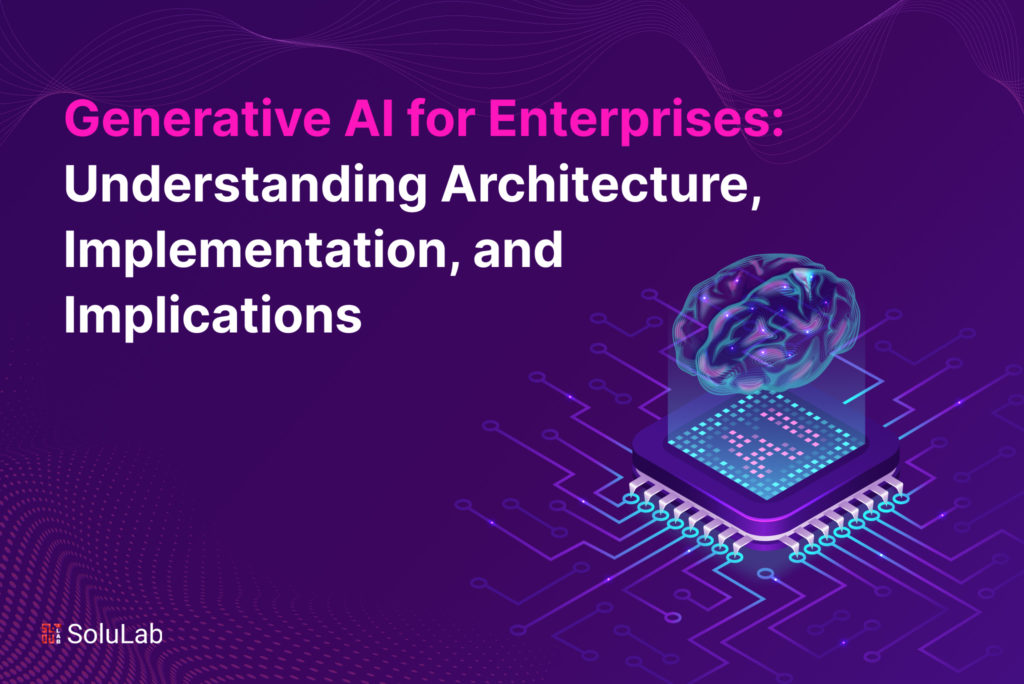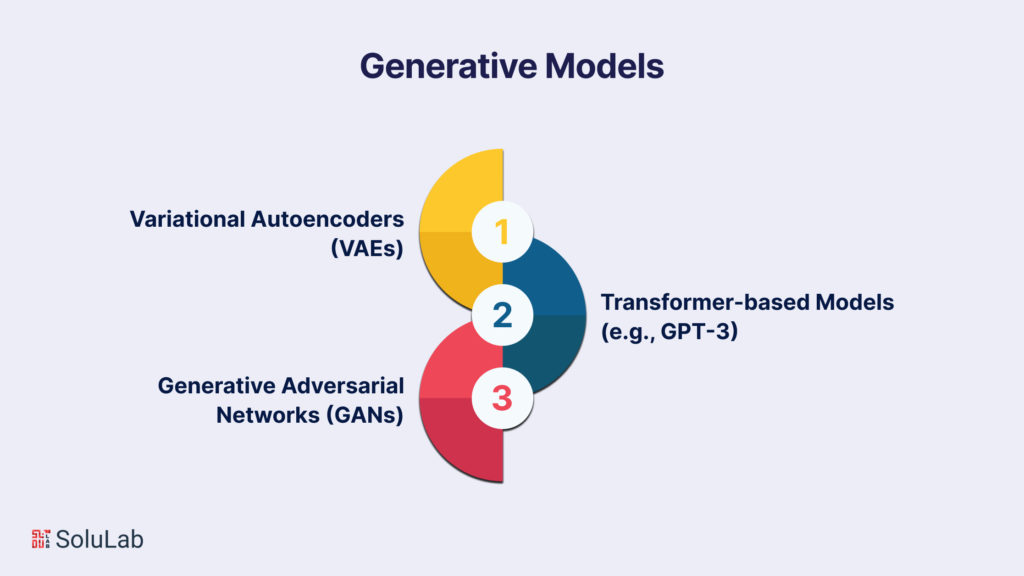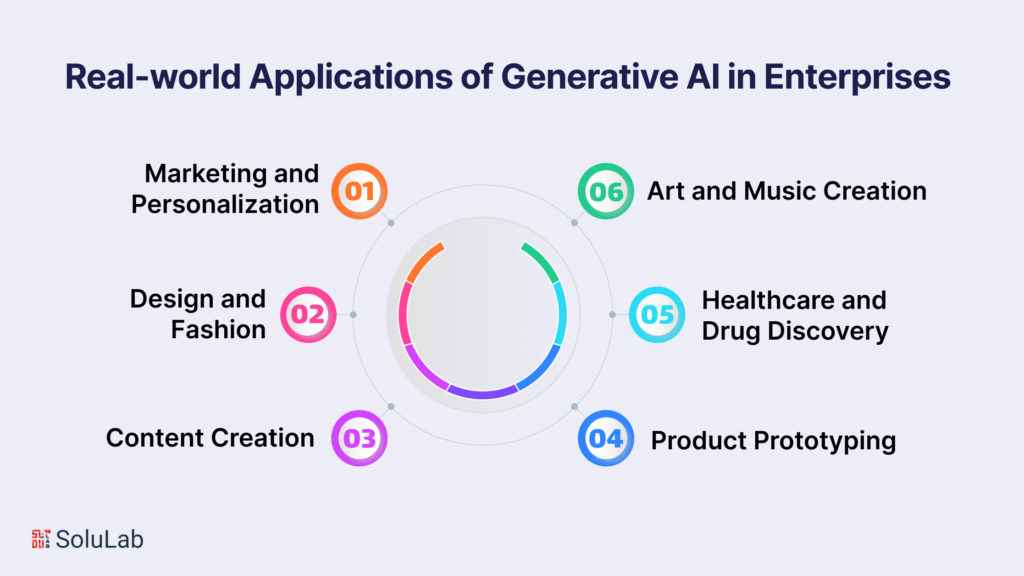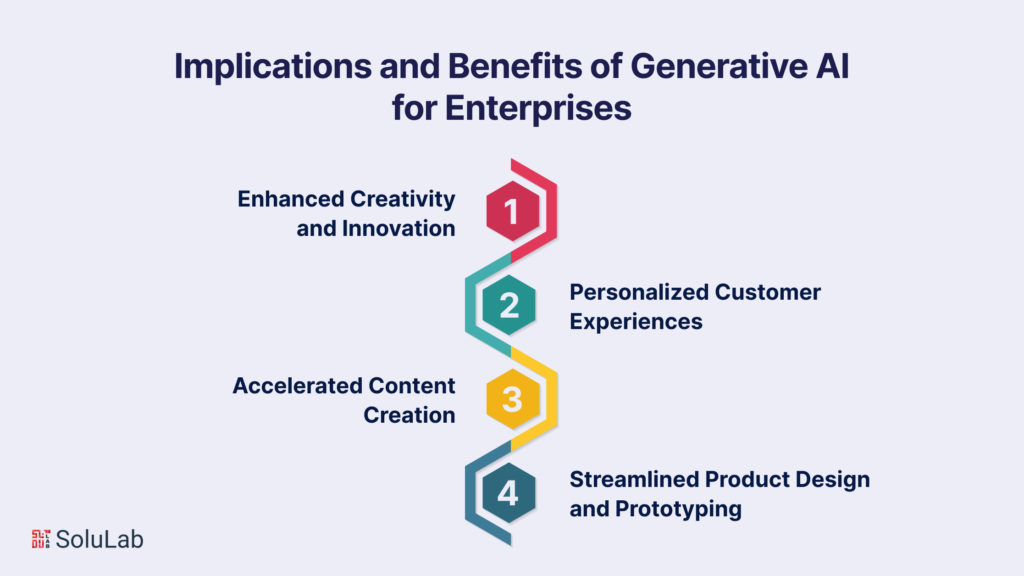
Generative Artificial Intelligence (generative AI) is a branch of artificial intelligence that focuses on the creation of new content, data, or information rather than just processing or analyzing existing data. Unlike traditional AI, which is primarily used for tasks such as classification and prediction, generative AI is concerned with producing outputs that resemble human-created content. This can include generating images, text, music, and even videos. In their daily jobs, 75% of knowledge professionals are actively using Generative AI technologies.
The importance of generative AI for enterprises cannot be understated. It opens up new avenues for creativity, innovation, and problem-solving. In a world where customization and personalization are key drivers of customer satisfaction, generative AI enables businesses to tailor their products and services to individual preferences. Furthermore, generative AI can streamline various processes, such as content creation and design, saving time and resources for organizations.
Understanding Generative AI Architecture
Generative AI architecture refers to the underlying framework of algorithms and models designed to create new and original content in various forms, such as text, images, music, and more. At its core, generative AI leverages complex neural networks, often utilizing architectures like Generative Adversarial Networks (GANs) or Variational Autoencoders (VAEs), to learn patterns and structures from existing data and then generate novel outputs that mimic the style and characteristics of the training data. This architecture involves a two-step process of learning representations and generating content: the learning phase involves training the model on a dataset, while the generation phase utilizes the learned representations to produce content that is not a direct copy of the training examples.
Explanation of Generative Models

Generative models lie at the heart of the generative AI architecture, driving its capacity to create new and meaningful content. These models are designed to learn the underlying patterns and structures present in a dataset and then generate novel examples that follow these learned patterns. Through their ability to produce content that resembles human-generated data, generative models have found applications in a wide range of creative and practical fields.
-
Variational Autoencoders (VAEs)
Variational Autoencoders (VAEs) are a type of generative model that combines elements of both encoding and decoding processes. The primary goal of a VAE is to capture the underlying latent structure of the input data. During training, VAEs learn to map input data into a lower-dimensional latent space, where each point in this space represents a meaningful encoding of the original data. This latent space can then be sampled to generate new data points that are consistent with the learned patterns.
VAEs have proven particularly effective in tasks such as image generation and data compression. They allow for the generation of new, yet plausible, data samples by sampling from the latent space distribution. This technique has applications in areas such as image synthesis, where VAEs can generate diverse and creative images based on their understanding of the dataset.
-
Generative Adversarial Networks (GANs)
Generative Adversarial Networks (GANs) introduce a unique architectural concept by pitting two neural networks against each other in a sort of creative competition. The generator network aims to produce data that is indistinguishable from real data, while the discriminator network aims to differentiate between real and generated data. These two networks are trained simultaneously in a process called adversarial training.
Over time, the generator becomes increasingly skilled at producing data that can fool the discriminator. This adversarial dynamic results in the creation of highly realistic data samples. GANs are widely used in image synthesis, where they have produced impressive results in generating photorealistic images, creating artistic styles, and even “deepfake” applications that merge or manipulate visual content.
-
Transformer-based Models (e.g., GPT-3)
Transformer-based models, exemplified by GPT-3 (Generative Pre-trained Transformer 3), have garnered significant attention for their language generation capabilities. Unlike VAEs and GANs, these models don’t rely on explicit encoding and decoding processes. Instead, they employ a mechanism called “attention” to process sequences of data in parallel, making them highly effective for processing language and text.
GPT-3 and its predecessors are trained on massive amounts of text data, learning to predict the next word or token in a sentence. This knowledge enables them to generate coherent and contextually relevant text given a prompt. These models have applications in automated content creation, natural language understanding, and even code generation.
How Generative AI Differs from Other AI Approaches?
Generative AI distinguishes itself from other AI approaches by its central objective: the creation of new content rather than the analysis or classification of existing data. Traditional AI, such as machine learning algorithms used for predictive modeling, focuses on extracting patterns from data to make informed predictions or decisions. Generative AI takes a leap beyond this by producing content that didn’t previously exist.
While traditional AI aims to uncover insights and relationships hidden within data, generative AI is a creative force that can devise entirely new ideas, artworks, and solutions. It’s this creative potential that sets generative AI apart and makes it a crucial tool for innovation in various fields.
Real-world Applications of Generative AI in Enterprises

Incorporating generative AI into these fields has the potential to revolutionize how enterprises operate, fostering innovation and enabling them to offer more personalized and creative solutions to their customers. Generative AI’s potential for innovation has led to its incorporation into numerous real-world enterprise applications:
1. Marketing and Personalization: Generative AI can create tailored advertisements and promotional content that resonate with individual customer preferences, thereby enhancing engagement and conversion rates.
For example: Coca Cola used generative AI to make ads that are more relevant to each customer’s tastes or interests. They made customized marketing strategies that greatly interested conversion rates and engagement by looking at the data about their customers.
2. Design and Fashion: In the design realm, generative AI can assist in generating intricate patterns, architectural designs, and fashion styles that are both unique and in line with trends.
3. Content Creation: For content creators, generative AI offers tools that automate the generation of blog posts, articles, and even scripts. This can significantly speed up the content creation process.
For example: The Associated Press has been using Generative AI to write news stories automatically, especially financial reports, because of this automation, they can quickly write thousands of pieces without sacrificing accuracy. This frees up reporters to do more in-depth reporting.
4. Product Prototyping: In product design, generative AI can swiftly generate and iterate through multiple design options, accelerating the prototyping phase.
5. Healthcare and Drug Discovery: Generative models can be utilized to generate molecular structures and predict potential drug candidates, aiding in drug discovery efforts.
For example: Insilico Medicine is making molecular structures, that use generative models to find possible drug options. This method speeds up the process of finding new drugs, which means that potential candidates could go into clinical trials faster than the traditional methods.
6. Art and Music Creation: Artists and musicians are using generative AI to produce new forms of creative expression, generating art pieces, musical compositions, and more.
Integration of Generative AI into Businesses
The successful implementation of generative AI in enterprises hinges on meticulous data preparation, model training, ethical considerations, and addressing challenges head-on. When executed effectively, generative AI has the potential to revolutionize how businesses interact with customers, create content, innovate in design, and even contribute to scientific and artistic endeavors. By understanding the nuances of each stage of implementation and embracing generative AI’s transformative capabilities, enterprises can position themselves at the forefront of technological innovation, staying ahead in an ever-evolving landscape.
Implementing generative AI in enterprises involves a strategic and thoughtful approach that encompasses data preparation, model training, ethical considerations, and addressing challenges that may arise. The successful integration of generative AI can yield transformative results across various aspects of business operations.
AI is the new trend now but adopting advanced machine learning technology into your organization demands a comprehensive plan for long-term success. These are the steps you need to follow to maximize Generative AI’s potential for your business:
1. Studying AI Pioneers
Successful integrations typically learn from others. Research early adopter firms to find best practices in strategizing, overcoming obstacles, and maximizing rewards, then apply these lessons to your business.
2. Creating a Learning Environment
Provide continual training and certifications to improve employee abilities. Team knowledge exchange and new projects foster ongoing learning.
3. Adapt Systems for Integration
To fully utilize these powerful technologies, optimize hardware and software. Find ways in which AI integration can improve the present systems, and investigate modular integration to reduce architecture integration platform as a service.
4. Be Responsible and Ethical
Reflecting your values when creating AI solutions to create a better strategy. Understand current and new AI legislation and be transparent in decision-making to maintain confidence and standards. Address bias and accountability problems to securely use these tools in your firm.
5. Choosing Business-Specific Solutions
Understanding your needs is key to choosing generative AI. General models have broad uses, but industry-specific tools can be effective and enhance analytics for improved decision-making.
Ethical Considerations in Generative AI
As with any technology, the implementation of generative AI raises ethical considerations. Enterprises must ensure that the content generated by their AI models adheres to ethical guidelines and does not propagate misinformation, hate speech, or other harmful content. Steps must be taken to prevent the model from generating biased or inappropriate outputs.
To address these concerns, AI developers can introduce constraints during training that encourage the model to generate content aligned with desired ethical values. Continuous monitoring of the model’s outputs is essential to identify and rectify any deviations from the intended ethical standards.
Addressing Challenges
Several challenges accompany the implementation of generative AI in enterprises:
Data Privacy and Security: Given that generative AI models learn from data, protecting sensitive information is paramount. Anonymizing or aggregating data can help maintain privacy while still enabling effective model training.
Mitigating Misuse: Generative AI models can be misused to produce fake content or manipulate information. Enterprises need to consider mechanisms to detect and combat such misuse.
Model Uncertainties: Generative AI outputs may not always be perfect and could include uncertainties. Communicating these uncertainties to users is important to manage expectations.
Resource Intensiveness: Training and deploying generative models require substantial computational resources and infrastructure.
Implications and Benefits of Generative AI for Enterprises

Generative Artificial Intelligence (generative AI) is poised to have a profound impact on how enterprises operate and innovate. Its ability to create new content, solve complex problems, and enhance customer experiences introduces a host of implications that extend across various aspects of the business.
Check Out Our Blog: Top 25 Generative AI Use Cases in 2025
-
Enhanced Creativity and Innovation
Generative AI offers enterprises a powerful tool to amplify their creativity and foster innovation. By generating novel ideas, designs, and concepts, businesses can break free from conventional thinking and explore uncharted territories. This can lead to the development of unique products, services, and solutions that stand out in competitive markets.
In creative industries like design, art, and fashion, generative AI provides a wellspring of inspiration. Designers can collaborate with AI to explore unconventional patterns and aesthetics, giving birth to entirely new artistic expressions. By automating certain aspects of the creative process, generative AI enables artists to focus on refining and elevating their work.
-
Personalized Customer Experiences
Customer-centricity is a cornerstone of modern business strategies, and generative AI empowers enterprises to deliver highly personalized experiences. By analyzing customer data, generative models can create content tailored to individual preferences. This ranges from personalized product recommendations in e-commerce to generating unique marketing content that resonates with each customer segment.
Generative AI’s ability to create personalized content at scale revolutionizes customer engagement. Enterprises can engage customers with targeted and relevant content across various touchpoints, leading to higher customer satisfaction, loyalty, and ultimately, increased revenue.
-
Accelerated Content Creation
Content creation is an essential component of marketing, branding, and communication strategies. Generative AI streamlines this process by automating the generation of content such as blog posts, social media updates, and product descriptions. This not only saves time but also ensures a consistent and frequent content output.
Enterprises can leverage generative AI to create content templates that align with their brand voice and messaging. These templates can be customized and iterated upon, enabling marketing teams to focus on strategy and refinement rather than the repetitive task of content generation.
-
Streamlined Product Design and Prototyping
In industries involving physical products, generative AI has the potential to revolutionize the design and prototyping phases. By inputting design parameters and constraints, generative AI can explore a multitude of design possibilities, offering a range of options that human designers might not have considered.
Generative AI’s iterative nature also accelerates the prototyping process. Enterprises can quickly generate and assess different prototypes, facilitating a more efficient design validation process. This agility enables businesses to bring innovative products to market faster, gaining a competitive edge in rapidly evolving industries.
Challenges and Considerations
While the implications of generative AI for enterprises are promising, there are challenges and considerations to navigate:
- Ethical Considerations: Ensuring that generative AI outputs align with ethical guidelines is crucial. Enterprises must actively prevent the creation of biased, offensive, or inappropriate content.
- Intellectual Property: Determining ownership of AI-generated content can be complex, raising questions about copyright and intellectual property rights.
- Quality Assurance: While generative AI can produce impressive outputs, not all generated content may meet the desired quality standards. Implementing quality assurance mechanisms is vital to maintain credibility.
- Data Security: Enterprises need to safeguard the data used to train generative models to prevent unauthorized access and potential breaches.
Conclusion
Generative AI presents enterprises with a multitude of opportunities to enhance creativity, innovation, customer experiences, and operational efficiency. By harnessing its capabilities, businesses can not only streamline processes but also unlock new avenues for differentiation in an increasingly competitive landscape. However, careful consideration of ethical concerns, intellectual property, and data security is paramount as enterprises navigate the implications of integrating generative AI into their operations. Through strategic implementation and a clear understanding of the implications involved, enterprises can leverage generative AI as a transformative force that propels them toward a future of unprecedented possibilities.
SoluLab, an innovative technology company, is at the forefront of harnessing the potential of generative AI to drive a revolution in enterprises. With an unwavering focus on enhancing creativity, streamlining efficiency, and elevating customer engagement, SoluLab seamlessly integrates generative AI into its operations including transformer-based systems and GAN to reshape the landscape of content creation, ensuring the delivery of unparalleled personalized experiences. In line with its dedication to upholding the highest standards of ethics and quality, SoluLab guarantees that all generative AI outputs are aligned with rigorous benchmarks. To achieve these groundbreaking feats, SoluLab is actively involved in providing top-notch Generative AI Development services. This involves utilizing cutting-edge technologies and hiring exceptional Generative AI developers who are adept at pushing the boundaries of what’s possible.
If you’re looking to stay ahead in the transformative realm of generative AI, connect with SoluLab today. Experience the future of enterprise innovation firsthand and explore the possibilities that this revolutionary technology brings to the table.
FAQs
1. What is enterprise generative AI?
Generative AI can forecast machine breakdowns using enormous datasets, enabling proactive maintenance. This decreases downtime, machine life, and maintenance expenses. Generative AI developers optimize manufacturing processes using machine learning and data analysis.
2. How may generative AI alter your business?
Generative AI Solutions may produce unique ideas based on trending market trends, product data, and customer preferences. AI technology can inspire and encourage organizations to explore creative ideas for product development.
3. What are generative AI examples?
Generative AI uses AI to create fresh images, texts, audio, videos, and music. Generative AI uses foundation models (big AI models) that can multitask and do unique tasks such as Q&A, classification, and more.
4. Which industry is benefiting the most from deep learning?
Medical and financial applications have shown the significance of deep learning and are benefiting the most from it. These models have improved the diagnosis of cancer and fraud detection in finance.
5. How can SoluLab use Generative AI to improve your operations?
Solulab is using generative AI to improve chatbot interactions, automate content creation, expedite code, and documentation, and optimize decision-making by creating data insights, improving operations efficiency and creativity.






